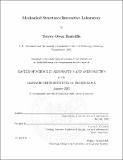| dc.contributor.advisor | Carlos E.S. Cesnik. | en_US |
| dc.contributor.author | Radcliffe, Torrey Owen, 1974- | en_US |
| dc.contributor.other | Massachusetts Institute of Technology. Dept. of Aeronautics and Astronautics. | en_US |
| dc.date.accessioned | 2005-05-19T14:57:24Z | |
| dc.date.available | 2005-05-19T14:57:24Z | |
| dc.date.copyright | 2002 | en_US |
| dc.date.issued | 2002 | en_US |
| dc.identifier.uri | http://hdl.handle.net/1721.1/16833 | |
| dc.description | Thesis (S.M.)--Massachusetts Institute of Technology, Dept. of Aeronautics and Astronautics, 2002. | en_US |
| dc.description | Includes bibliographical references (p. 53-54). | en_US |
| dc.description | This electronic version was submitted by the student author. The certified thesis is available in the Institute Archives and Special Collections. | en_US |
| dc.description.abstract | The Mechanical Structures Interactive Lab is one of a number of new remotely accessible WebLabs being developed at the Massachusetts Institute of Technology. WebLabs allow students access to physical experiments from anywhere at anytime via the World Wide Web. While these cannot replace laboratories that are more traditional, they facilitate lab assignments when traditional labs are not practical. The Mechanical Structures Interactive Laboratory is a framework for allowing remote experimentation on elastic structures. Users of the system are able to obtain data from experiments they perform on the structures form a remote location. The system is designed to allow new experiments to be easily added, and can support all levels of mechanical structures courses currently oered at MIT. The system can be used by multiple courses in multiple departments of multiple universities. Users are only required to have a computer connected to the World Wide Web and they can send actuator commands and monitor sensor responses in near real time. The typical student is expected to spend between fifteen minutes to an hour using the system to obtain experimental data. A queuing system regulates (and allows monitoring of) system usage. All of the software was developed using National Instruments G language. Unlike similar systems, the Mechanical Structures Interactive Lab does not use any sort of Java based applications. The system has been tested in a small graduate course. The students used a piezoelectric actuator to stimulate a beam and monitored the response using strain gauges, laser displacement sensors and a webcam. By using the same computer to both model the beam and perform experiments, the students received rapid feedback on the accuracy of their numerical models. While most of the feedback received was positive, there are still a number of areas for system improvement. While work is still being done to make these improvements, the system has shown itself to be an effective means of providing a positive educational experience to engineering students. | en_US |
| dc.description.statementofresponsibility | by Torrey Owen Radcliffe. | en_US |
| dc.format.extent | 80 p. | en_US |
| dc.format.extent | 8463826 bytes | |
| dc.format.extent | 8463595 bytes | |
| dc.format.mimetype | application/pdf | |
| dc.format.mimetype | application/pdf | |
| dc.language.iso | eng | en_US |
| dc.publisher | Massachusetts Institute of Technology | en_US |
| dc.rights | M.I.T. theses are protected by copyright. They may be viewed from this source for any purpose, but reproduction or distribution in any format is prohibited without written permission. See provided URL for inquiries about permission. | en_US |
| dc.rights.uri | http://dspace.mit.edu/handle/1721.1/7582 | |
| dc.subject | Aeronautics and Astronautics. | en_US |
| dc.title | Mechanical structures interactive laboratory | en_US |
| dc.title.alternative | Remotely-operated academic structural dynamics lab | en_US |
| dc.type | Thesis | en_US |
| dc.description.degree | S.M. | en_US |
| dc.contributor.department | Massachusetts Institute of Technology. Department of Aeronautics and Astronautics | |
| dc.identifier.oclc | 51277095 | en_US |
